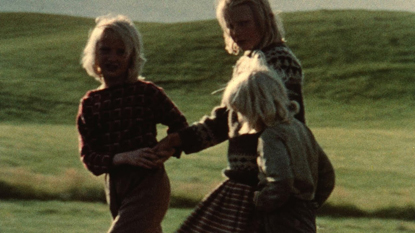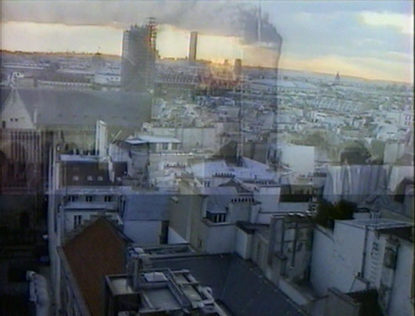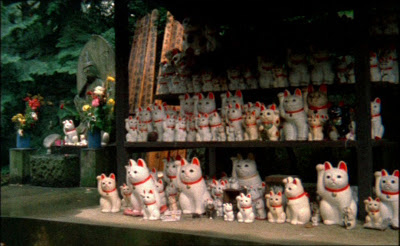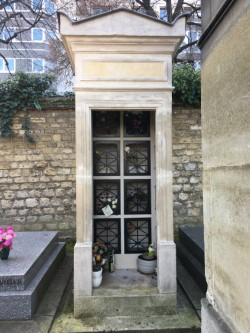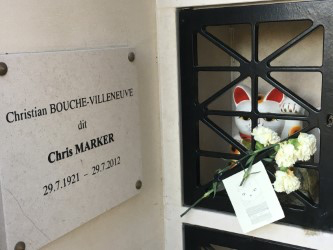Missing Marker
Sarah Cooper
I have thought a great deal about Marker over the years since his death in 2012, but it is only recently that I have begun to miss him. The Charlie Hebdo attack in Paris in 2015 was the catalyst for my belated feeling of loss. I wondered how he would have responded to what happened that day, and have asked that same question each time a cataclysmic event has occurred in France and elsewhere ever since, increasingly conscious of his absence. Marker was not a personal friend of mine; I had never met nor had I interviewed him, and all that has ever connected me to him is a passion for his films, their awe-inspiring commentaries on global events, poetic wisdom, and stunning images. In keeping with Roland Barthes’s proclamation of the death of the author, I treated Marker as always already absent from his work. Yet that paradox of distant intimacy that comes from engaging in-depth with someone else’s work in such a manner while they are still living established a relation that his actual death has necessarily altered. More accurately, therefore, I miss what Marker will never add to the existing body of work gathered under his name: I miss what I will never have, not something I had and have lost.
This places what I miss as a result of his death at some remove from renowned models of loss and absence. Within Freudian psychoanalysis death is the model for understanding all kinds of loss, which means that these experiences are based structurally on losing something or someone forever and never being able to get them back. Within Sartrean philosophy, death might be thought of as the extreme version of the absence essential to his theory of imagination. In the imagination, someone or something is always missing for Sartre, even though intended by the imaging consciousness; the transparent mental image conjured forth as if by magic pales in comparison to the actual person or thing, a ghostly stand-in at best. In contrast to these models of loss and absence that are missing something or someone, nestling at the heart of Marker’s work and fundamental to his practice is a staging of loss without an object, which invites the spectator to imagine what the filmmaker has never made visible. Fittingly, then, it is Marker’s films that have always offered the best way of coming to terms with his future disappearance.
This realization began for me with the image of three children holding hands as they walked along a road in Iceland in the sunshine in 1965, dishevelled by the wind: Sans Soleil (1982) was the first film by Marker that I ever saw. Marker, by means of his alter ego Sandor Krasna, and the voice of Florence Delay in French (Alexandra Stewart in English), says that he had tried several times to link this image to other images, and that it never worked. Its presence at the start of Sans Soleil is the best he can do, as the voice-over narration concedes: “If they don’t see happiness in the picture at least they’ll see the black.” The black leader relates directly to the sunless dimension of the title—a blacked out moment corresponding to the absence of light, the materiality of film acquiring meaning by association, from the title through the representational images to the darkness. That which enables sight is removed the better to showcase a vital presence—of light, of visual imagery, of happiness—as montage reveals an indistinct absence, a loss of nothing in particular, as well as what is there. Marker is thus shining a light through the cut of montage to the mind, suggesting a turn towards what has never been visible to the eye, only perhaps to an inner eye that feels through space as readily as it may envision mental pictures. Born from the sunless darkness of the absence of visual imagery that materializes in the black leader, these mental pictures and the imagination have long been important to Marker’s work and emerge through his unique approach to montage.
André Bazin writes famously of Marker’s “horizontal” montage in Lettre de Sibérie (1957) that it is formed from ear to eye, prioritizing the spoken word, with the image intervening in the third position in reference to this verbal intelligence.[1] Yet Marker also activates the mind’s eye that sees in excess of the images on screen, creating a layering of image and imagination rather than just comprehension of what is said being measured against the visible onscreen image. This activity is a function of the epistolary address that divides the place and time of writing from the place and time of reading/viewing. I have written elsewhere about this spatial-temporal disjunction: “Caught between home and this far-off land, between aural commentary and mental impression, the film’s images are very much at home in their distant country of origin, whereas the intelligence whose expression is the spoken word constantly veers away from the time and place of writing.”[2] It is the “mental impression” that is important here. Montage shifts attention from perception (ear/eye) to imagination (inner ear/eye). The imaginative space is not the literal onscreen visualization of a creative emotional geography that one might be inclined to align with latter-day variations on the Kuleshov effect. Nor is it produced through the kind of calculated juxtaposition associated with Eisenstein’s montage in which two onscreen visual images combine to produce a third in the viewer’s mind. Rather, it emerges beyond the visual realm, indebted to the verbal, but reducible to neither, brought out image upon image in the light of the mind, poetically rather than mathematically or geometrically.
I like to imagine that the films Marker would still be making in the light of recent political events would reflect the spirit of such earlier work, and perhaps pick up where the later Chats perchés (2004) left off. The graffiti cats that appeared across Paris in 2001 and became the elusive subject of this film were linked to political uncertainty and the threat of the rise of the far right. A generation who mobilized themselves in protest to fight this are captured on film, as Marker engages in a detective’s journey across Paris from the time of 9/11 to the time of the French presidential election, charting the disappearance and then reappearance of the cats and affirming that wherever humanity is heading in the future, the cats are needed. This film in its French version is less dependent than his earlier essay films are on the spoken word—there is no voice-over—and written inter-titles, as well as diegetic sound, only occasionally orient the flow. The juxtaposition of images therefore does not engage verbal intelligence first as Bazin declared with regard to horizontal montage, moving from ear to eye. Instead, an occasional layering of images through superimposition serves the purpose of making an innovation in Chats perchés with regard to montage and creates an opening for spatial thinking. The space for the creation of imagined images in the mind different from those on screen may be initiated in the earlier films through the poetic voice-over, but the hinterland of the perceived images is prompted differently in this late work.
Towards the start of the film a shot of the city skyline in Paris shows fleetingly the twin towers of New York under attack. Based in Paris and traversing the geography of the city, the film is also linked to the tragic event that caused a seismic shift on the world stage taking place elsewhere at the time of the film’s conception. The image is visibly in Paris, but there is a faint view of the towers, which then fades, as the film remembers, juxtaposing the two spaces simultaneously within the same shot rather than side-by-side. This effect of spatializing the image, lending it depth by revealing an elsewhere within the actual geographical present, is a visual corollary of the effect of the production of mental images from the verbal commentary in Lettre de Sibérie. Chats perchés shows within this opening image the spatial-temporal layers that have always been there, albeit invisibly and as an ostensible absent image in other work, present only in the mind. In other sequences this connection is instated aurally. Arletty’s voice from Marcel Carné’s Hôtel du Nord (1938) is heard over images of the Canal St. Martin, and recollects this film, perhaps recalling images too for those who have seen it. Furthermore, an AIDS protest on the Champ de Mars begins in colour, showing hundreds of bodies, as the images gradually turn to black and white and are stilled. The music that plays over this black and white sequence is from Alain Resnais’s Hiroshima mon amour (1959) and the focus on the limbs of those lying side-by-side recalls the opening shot of Resnais’s film in which it is unclear whether they belong to lovers or are the dismembered bodies of those killed in the fall-out from the nuclear attack. An apocalypse is called to mind here beyond what is seen on screen between past and present, from film to film, in the enmeshing of sound and image.
There is always another image, then, that is not present in Marker’s work, one that is to be brought to the films by spectators, mentally and creatively, at times summoning up memory but not always. Between mind and screen, the full picture is yet to materialize completely, and it is by complementing it imaginatively from different perspectives while never being able to do so fully and finally, that spectators have always been called upon to appreciate his films. Missing what I will now never have is not entirely resolved through these observations, since Marker will of course never add to his corpus of films, but this does affirm that the responsibility for the future image lies with his spectators. He had the good grace to leave behind myriad cats to facilitate this ethical journey through what will continue to be testing times ahead.
In December 2016, after reading Maroussia Vossen’s book in which she reflects as his adopted daughter on her “père putatif” (imaginary father) as she transports his urn across Paris,[3] I paid a visit to Marker’s commemorative resting place in Montparnasse cemetery. A beckoning cat—so familiar from Sans Soleil—guards the door of his small room in the columbarium and an owl smaller in stature sits alongside. While the owl and the pussycat of the well-known nursery rhyme set sail in a beautiful pea green boat, their position as Marker’s eternal symbolic companions is in a location more akin to a stone TARDIS, an appropriate abode for the time traveller who did however know that he could not escape time. This, after all, is the ultimate lesson of La Jetée (1962), one of the films that he wanted to mark the birth of his career ten years after it actually began. Moreover, Marker’s birthdate is also the date of his death, reflecting the temporal loop of La Jetée as well as the future anteriority of the photograph that is its basis.[4] Sans Soleil continues the time travel in different ways, also inevitably encountering absence and loss. The humility of a Japanese couple in Sans Soleil touched Marker when they visited the Gotokuji cat temple to pray for their cat Tora who had gone missing: “Cat, wherever you are, peace be with you.” My final wish for Marker has the same simplicity, accompanied by gratitude for the gift of his films and for the images that are still to come.

Figure 4. Marker’s commemorative resting place in a columbarium, Montparnasse cemetery (the owl is obscured by the carnations here, photograph taken December 2016)
Sarah Cooper is Professor of Film Studies at King’s College London. Her books include Selfless Cinema?: Ethics and French Documentary (Oxford: Legenda, 2006); Chris Marker (Manchester: Manchester University Press, 2008); and The Soul of Film Theory (Basingstoke: Palgrave-Macmillan, 2013). She has also edited a special issue of the journal Film-Philosophy, “The Occluded Relation: Levinas and Cinema” (vol. 11, no. 2, 2007). Currently she is writing a book on film and the imagination.
Notes
- André Bazin, “Chris Marker: Lettre de Sibérie,” [1958] in Le Cinéma français de la Libération à la Nouvelle Vague (1945-1958) (Paris: Cahiers du cinéma, 1998), 257-260 (p. 259).
- Sarah Cooper, Chris Marker (Manchester: Manchester University Press, 2008), 26.
- Maroussia Vossen, Chris Marker (Le Livre Impossible) (Paris: Le Tripode, 2016), 16.
- See Roland Barthes, Camera Lucida: Reflections on Photography, trans. Richard Howard (New York: Hill & Wang, 1981 [1980]).

